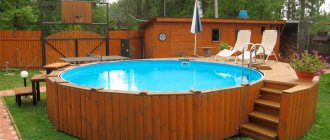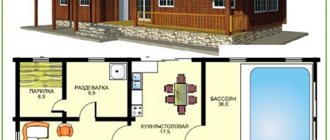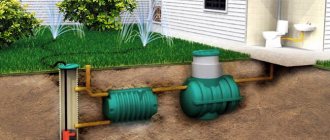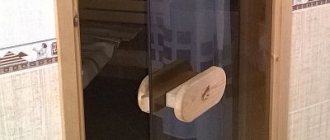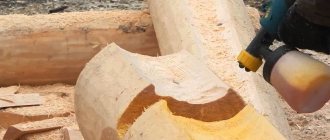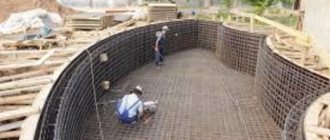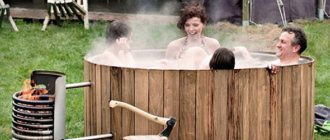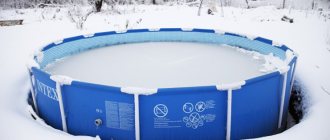On a hot summer day, it’s difficult to deny yourself the pleasure of cooling off in a cool pond. Not everyone has a country house on the banks of a river or lake, and building a permanent pool requires space, time, and material costs.
Is there an alternative to capital expensive construction? Fortunately, people's ingenuity did not ignore this issue. We have selected not just the most interesting and simple ideas, but also the most viable ones that can be realistically implemented on a summer cottage without special skills.
The presented structures are not designed for 10-year use; they do not comply with all swimming pool construction standards. But the authors set completely different goals: cheap, fast, seasonal. Nevertheless, certain rules must be followed during such construction, so first we will familiarize ourselves with the general recommendations.
Important points when planning and building a homemade pool
Regardless of the choice of material for the construction of a seasonal pool, we recommend paying attention to the following points:
- the place for the pool should be in direct sunlight, and not in the partial shade of the garden: the water will heat up faster and there will be less debris in the form of falling leaves and insects;
- the area must be leveled and compacted;
- the bottom and walls of a homemade bowl should not have sharp protrusions or a hard surface;
- you need to immediately think about how and where the water will be drained during regular replacement (especially if installing filters is not provided);
- the frame needs to be strengthened so that the structure does not fall apart under water pressure;
- when purchasing a waterproofing film (tarpaulin), take into account the size of the container with a margin of 50 cm around the entire perimeter.
When installing a budget pool, do not forget about landscaping the area around it. You can make an embankment of pebbles or river sand around the perimeter, decorate the approaches with decking boards, or simply knock down wooden flooring from old pallets. Also, for comfort, it is advisable to consider a towel rack.
Filling methods
Baths come in overflow types with built-in drainage grates on the sides. Water is poured to the very top and, splashing out, pours into the container, passing through the filter.
The skimmer method involves not bringing the liquid level to the very edges by 15-25 cm; in this case, it is cleaned with a skimmer.
Just dig a hole and cover it with film
The first stage is the most labor-intensive - digging a hole of suitable size and depth. When the pit is ready: the bottom is leveled and compacted, the walls are perpendicular to the bottom and are not crumbling, proceed to the second stage - preparing the surfaces.
Cut cardboard boxes are laid on the bottom to make it soft to step on. The walls are covered with bags so that the film does not tear on uneven surfaces and plant roots.
At the third stage, the pit is covered with waterproofing film. The upper edge is pressed with stones, which additionally plays the role of decoration.
You can bury a bowl made of scrap materials, covered inside with film, into the soil. This will require a lot of effort, but it will be possible to increase the depth of the pool. Since the edges of the bowl protrude above the soil surface, the soil will not be washed into the water.
Location
The location of the tank is of great importance. This takes into account:
- Soil components.
- Lack of tall deciduous vegetation nearby.
- Occurrence of underwater sources.
- Soil slope.
- Distance to water supply.
- Wind rose.
Placement under trees is not recommended, otherwise the water will become clogged with falling leaves and branches, which will cause its frequent replacement. The proximity of water pipes guarantees quick filling and easy cleaning. Stationary structures are built inside the building, and any variety is built outside.
An indoor pool is popular, providing protection from the scorching sun in the heat and allowing you to take water treatments in late autumn, if there is heating.
Frame pool made from pallets
To begin, choose a flat area and cover it with a thick tarpaulin (perhaps an old banner or canopy). Next, take 9 pallets and fasten them with screws and slats. Pallets are placed on edge, connected by a ring. When the round frame is ready, it is secured with tie straps for additional rigidity.
At the next stage, the inner surface of the “bowl” is covered with thick greenhouse film, and old towels, bedspreads or blankets are placed on top at the junction of the pallets and on the bottom. This is done to soften the surface so that while swimming it is comfortable to press against the stacks and walk along the bottom.
The final layer is a waterproofing film. If it is blue or blue, the water in the pool will always be bright. Some advise using black film to improve water heating. It is important that under the film there are no open sharp corners, protruding boards or rough surfaces on which the film will quickly tear.
The film is secured to the top edge of the pallets using a special adhesive tape. For decorative finishing of the outside of the pool, you can use reeds or bamboo. Narrow boards are nailed on top to hide the pallets.
The frame can also be made rectangular by connecting the pallets at right angles. The bottom can also be lined with pallets.
To create the most comfortable area, you can attach a lighting stand to the corner and make steps from pallets.
These pools are filled with tap water from a garden hose and drained manually or using a low-power pump. If chemicals were not used for disinfection, then vegetable beds and flower beds can be safely watered with water.
Preliminary design
A swimming pool with complex utilities - water heating, cleaning, filtration.
A do-it-yourself pool at the dacha is a complex design. In order for the water in an artificial reservoir to always be sufficiently fresh and clean, it is necessary to plan the correct drainage and supply of water, liquid purification, the possibility of carrying out disinfection procedures, and much more.
Designing a reservoir includes several stages.
- Architectural - determine the size and shape of the bowl, the location of the pool. They think through the filtration system and plan the placement of service equipment. It is important to develop a general design, select finishing and decorative materials.
- Calculations - taking into account the characteristics of the soil on the site and its topography, a pool design is chosen - frame, frameless. The type is determined by the parameters of the building material and the installation method.
- Structural - at this stage, the design of load-bearing parts is developed, the method of waterproofing, finishing, and protection is chosen. The pool bowl is subjected to enormous pressure; an error at the design stage leads to deformation of the bottom and walls.
- Design of communications - calculate the length and cross-section of inlet and outlet pipes, pump power, filtration and power supply systems.
The result of creating a sketch of a reservoir is a package of documents, including drawings of the pool and all the main elements, a technical description of the components, a review of installation recommendations, and a list of materials. The list also includes an estimate of the work.
The project includes a survey and assessment of the selected installation site.
Pool made from old boxes
The frame of the pool can be made from old wooden or plastic boxes. They make up a rectangular box, fasten each one together and additionally wrap it around the perimeter with plastic tape.
The structure is assembled on a tarpaulin. The inside of the box is covered with a thick waterproofing film, pressing the top edge with wooden boards.
Tools for work
Polypropylene film for soil waterproofing
Materials and tools are selected based on the type of pool and design. You will need:
- shovel, pickaxe, if you plan to dig a trench; if the pit is large, you need to rent special equipment;
- frame material - pallets, boxes, metal pipes, reinforcement for a concrete bowl;
- tools for processing materials - plane, jigsaw, hacksaw, saw, etc.;
- measuring instruments - tape measure, plumb line, level;
- fasteners - screws, nails, metal corners, tape, etc.;
- waterproofing film;
- concrete if a permanent pool is being built;
- finishing or cladding materials – paint, varnish, tiles:
- maintenance materials - pipes, nozzles, flanges, pump, skimmer or storage tank if the pool is drained.
Additional materials and equipment: concrete mixer, screwdriver, construction stapler, felt and so on.
A pond made of hay - simple and cool
Looking for available materials for the construction of a swimming pond in the dacha sector, enthusiasts turned their attention to hay, which is an indispensable attribute of agricultural land.
It is spread out on a prepared area, and sides are built from rectangular compressed bales. Further, everything is according to the already shown scheme: a thick film is covered in the resulting bowl, the structure is tightened with belts. To protect the waterproofing film from damage, cardboard or a thick tarpaulin can be placed on the hay as the first layer.
Types of structures
Before you start designing and drawing up estimates, select the type of structure. This parameter determines the technology for performing the work and allows you to select the optimal materials.
Main types of country pools:
1 Frame - sold ready for installation. They look like a metal base on which a fabric (usually PVC film) is stretched. There are basic and complete sets of swimming pools - with a cleaning system, pump, ladder. Installation and use are seasonal. Waterproofing is required
Frame pool
2 Plastic – with polymer bowls. Plastic pools can be purchased ready for installation or ordered to be made to order. Also a seasonal – that is, summer – solution. The plastic pool must be removed in winter to avoid damage to the materials.
Plastic pool
3 Stationary – these are monolithic structures for permanent use. We will consider their arrangement below. Yes, building a stationary country pool requires a significant investment of time and money, but in the end you get a working solution that is easy to use. Reliability is high, durability is also good
Stationary pool option
Inflatable pools are also used - but this is a very simple, short-lived material . It’s easy to pierce even the most expensive product, and you’ll have to replace it. Small inflatable products can be placed in the children's area.
Pools with different depths should have a flat bottom with smooth transitions. Sudden changes are unacceptable for safety reasons.
Pool on a metal frame
For those who are familiar with welding, it will not be difficult to make a simple pool with your own hands from metal.
Each wall is made separately from a profile pipe and galvanized sheet. The structure can be assembled by welding or made dismountable with bolts.
An insert made of waterproofing film is installed inside, which, if desired, can be made to order according to the dimensions of the resulting structure. You can decorate such a pool using flooring from pallets, and also make a cover.
To increase ease of use, it is recommended to install a pump with a filter and use disinfectants for regular use. Thanks to this, your pool will not turn into a muddy swamp in a few days, the water from which will need to be completely pumped out and replaced with new water on a regular basis.
Rules of service
The disadvantage of most homemade pools is that it is difficult to organize normal water filtration in them. Some tanks do not require the installation of additional equipment, so such bowls require more chemicals and more frequent cleaning.
Care:
- If the drainage is not done on the beds, it is necessary to use disinfectant chemicals.
- Once every 1-2 days, the bottom and surface cleaning of the bowl is carried out.
- Before winter, half the water is drained, and plastic bottles partially filled with sand are placed inside. This way the walls will be protected from cracking.
Mini-pool made from a large tire
Our selection will be completed by a very simple idea for making a pond from a large diameter tire from heavy special equipment.
To expand the future pool, the first step is to trim the sidewalls of the tire. The resulting workpiece is installed on a previously prepared concrete platform and filled with concrete. Thus, the tire and concrete form a bowl, which, after the concrete has dried inside, must be painted with a special paint.
As a result, you will get, albeit small, but not requiring much effort in maintenance and a very cozy pond that will help you cool off on hot days.
Calculation of required materials
The pit for the pool can be lined with bricks.
If we are talking about mini-reservoirs made of car tires or straw, you can handle the calculations yourself. If a concrete bowl is being built, the calculations are much more complicated. It is better to entrust them to a specialist.
Please take into account:
- Number of users. On average, for swimming 1 person, a depth of 1.5 m is required, and the length of the pool is 5 m. The more users, the larger the size of the bowl. At the same time, the depth remains unchanged. Although for large sizes it is recommended to make the reservoir at different levels.
- The deeper and more voluminous the bowl, the greater the volume of water pressing on the bottom and the thicker the walls of the pool should be. The value is calculated based on the strength indicators of the material used.
- The more complex the configuration of the reservoir, the more complex the calculations. The easiest way to build a round or rectangular home pool.
- It is necessary to accurately determine the placement of incoming and outgoing pipes. If something was missed at the planning stage, holes for communications will have to be drilled in a concrete bowl, which is difficult and expensive.
The design of the pool and the thickness of the walls are also influenced by the nature of the soil, the groundwater level, and the topography of the site. Assessing such factors requires special knowledge.
